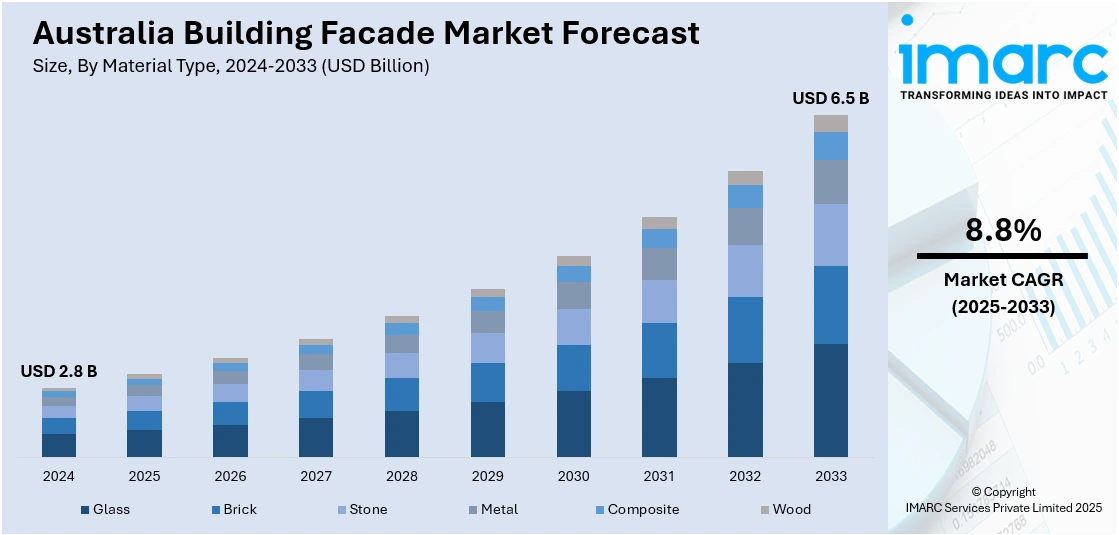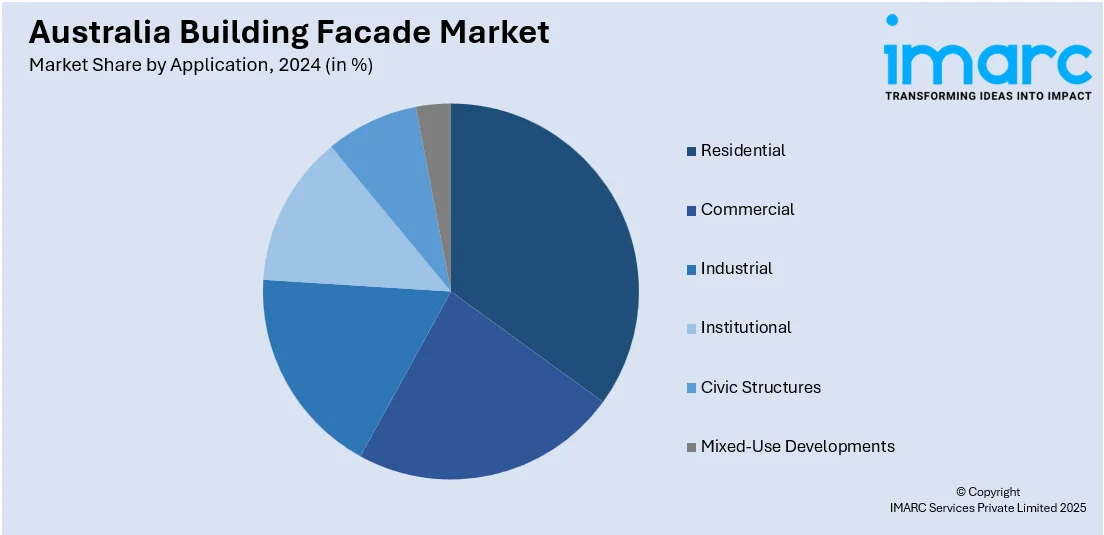
Australia Building Facade Market Size, Share, Trends and Forecast by Material Type, Product Type, Application, End User, and Region, 2025-2033
Australia Building Facade Market Overview:
The Australia building facade market size reached USD 2.8 Billion in 2024. Looking forward, IMARC Group expects the market to reach USD 6.5 Billion by 2033, exhibiting a growth rate (CAGR) of 8.8% during 2025-2033. The market is driven by rapid urbanization, increasing demand for energy-efficient designs, and growing construction activities. Additionally, advancements in facade materials, heightened focus on aesthetics, and sustainability goals are propelling the Australia building facade market share.
|
Report Attribute
|
Key Statistics
|
|---|---|
|
Base Year
|
2024 |
|
Forecast Years
|
2025-2033
|
|
Historical Years
|
2019-2024
|
| Market Size in 2024 | USD 2.8 Billion |
| Market Forecast in 2033 | USD 6.5 Billion |
| Market Growth Rate (2025-2033) | 8.8% |
Australia Building Facade Market Trends:
Technological Advancements in Facade Materials
Technological innovations in materials used for building facades are playing a crucial role in shaping the Australia building facade market growth. Newer materials, such as high-performance glass, composites, and smart facades, offer benefits like better insulation, energy efficiency, and improved aesthetic appeal. For instance, 550 Spencer in West Melbourne is Australia’s first building to generate its own electricity through a solar panel façade. The eight-storey building, designed by Kennon, uses 1182 PV panels on its façade, producing energy without battery storage. This innovation saves 70 tonnes of carbon emissions annually and achieves a 5-star Green Star rating. These technologies are gaining greater significance in the commercial and residential building industries, as builders and architects aim to meet sustainability targets and energy-efficient construction. The development of high-tech facades that adapt to environmental conditions, including temperature and light, is greatly enhancing the demand for such materials. This trend toward advanced materials is also consistent with the increasing demand for green and environmentally friendly buildings throughout Australia.

To get more information on this market, Request Sample
Sustainability and Energy Efficiency
Sustainability is a top trend in the Australia building facade market. The increasing focus on energy-efficient design is fueling the uptake of facades that assist in thermal performance of buildings to minimize energy consumption. Facade designs that integrate insulation technologies, solar panels, and green walls are becoming increasingly popular since they keep in line with environmental sustainability goals framed by government policies and consumers' needs. For instance, as per 2024 industry reports, Biophilic design, emphasizing natural materials, is reshaping Australia's architecture with terracotta and brick facades. These materials offer timeless appeal, blending modern aesthetics with sustainability. Terracotta provides a durable, energy-efficient option, while brick's versatility creates unique, culturally resonant designs. Both materials are evolving with innovations like lightweight panels, enhancing energy efficiency and ease of installation, contributing significantly to Australia’s building facade trends. Moreover, the demand for buildings that meet green building standards, such as LEED and Green Star, is accelerating the use of sustainable building facades. This trend not only contributes to reduced energy costs but also improves indoor comfort, helping buildings meet strict environmental and energy efficiency standards, which fuels the Australia building facade market growth.
Australia Building Facade Market Segmentation:
IMARC Group provides an analysis of the key trends in each segment of the market, along with forecasts at the region/country level for 2025-2033. Our report has categorized the market based on material type, product type, application, and end user.
Material Type Insights:
- Glass
- Brick
- Stone
- Metal
- Composite
- Wood
The report has provided a detailed breakup and analysis of the market based on the material type. This includes glass, brick, stone, metal, composite, and wood.
Product Type Insights:
- Prefabricated Facades
- Modular Facades
- Cladding Systems
- Unitized Systems
- Rain Screen Systems
- Custom Designs
A detailed breakup and analysis of the market based on the product type have also been provided in the report. This includes prefabricated facades, modular facades, cladding systems, unitized systems, rain screen systems, and custom designs.
Application Insights:

- Residential
- Commercial
- Industrial
- Institutional
- Civic Structures
- Mixed-Use Developments
The report has provided a detailed breakup and analysis of the market based on the application. This includes residential, commercial, industrial, institutional, civic structures, and mixed-use developments.
End-User Insights:
- Architects and Designers
- Construction Companies
- Real Estate Developers
- Building Owners and Managers
- Government and Regulatory Bodies
- Consultants and Engineers
The report has provided a detailed breakup and analysis of the market based on the end-user. This includes architects and designers, construction companies, real estate developers, building owners and managers, government and regulatory bodies, and consultants and engineers.
Regional Insights:
- Australia Capital Territory & New South Wales
- Victoria & Tasmania
- Queensland
- Northern Territory & Southern Australia
- Western Australia
The report has also provided a comprehensive analysis of all the major regional markets, which include Australia Capital Territory & New South Wales, Victoria & Tasmania, Queensland, Northern Territory & Southern Australia, and Western Australia.
Competitive Landscape:
The market research report has also provided a comprehensive analysis of the competitive landscape. Competitive analysis such as market structure, key player positioning, top winning strategies, competitive dashboard, and company evaluation quadrant has been covered in the report. Also, detailed profiles of all major companies have been provided.
Australia Building Facade Market News:
- In October 2024, Fletcher Building partnered with the Back Country Trust to restore 30 iconic backcountry huts in New Zealand. The five-year collaboration provides building materials at reduced costs, helping with repairs and renovations. Fletcher employees can volunteer, and the initiative aims to preserve these vital huts for outdoor enthusiasts while promoting community engagement.
- In March 2024, Mirvac, a major player in real estate and construction, known for implementing high-quality building facades with modern and eco-friendly designs, completed the first warehouse at the Aspect Industrial Estate in Kemps Creek, Western Sydney. This $660 million logistics project spans 56 hectares and offers 247,000 sqm of space, focusing on flexibility, technology, and sustainability. Featuring 1,510 solar panels, the warehouse supports job creation and economic growth in the region.
Australia Building Facade Market Report Coverage:
| Report Features | Details |
|---|---|
| Base Year of the Analysis | 2024 |
| Historical Period | 2019-2024 |
| Forecast Period | 2025-2033 |
| Units | Billion USD |
| Scope of the Report |
Exploration of Historical Trends and Market Outlook, Industry Catalysts and Challenges, Segment-Wise Historical and Future Market Assessment:
|
| Material Types Covered | Glass, Brick, Stone, Metal, Composite, Wood |
| Product Types Covered | Prefabricated Facades, Modular Facades, Cladding Systems, Unitized Systems, Rain Screen Systems, Custom Designs |
| Applications Covered | Residential, Commercial, Industrial, Institutional, Civic Structures, Mixed-Use Developments |
| End Users Covered | Architects and Designers, Construction Companies, Real Estate Developers, Building Owners and Managers, Government and Regulatory Bodies, Consultants and Engineers |
| Regions Covered | Australia Capital Territory & New South Wales, Victoria & Tasmania, Queensland, Northern Territory & Southern Australia, Western Australia |
| Customization Scope | 10% Free Customization |
| Post-Sale Analyst Support | 10-12 Weeks |
| Delivery Format | PDF and Excel through Email (We can also provide the editable version of the report in PPT/Word format on special request) |
Key Questions Answered in This Report:
- How has the Australia building facade market performed so far and how will it perform in the coming years?
- What is the breakup of the Australia building facade market on the basis of material type?
- What is the breakup of the Australia building facade market on the basis of product type?
- What is the breakup of the Australia building facade market on the basis of application?
- What is the breakup of the Australia building facade market on the basis of end user?
- What is the breakup of the Australia building facade market on the basis of region?
- What are the various stages in the value chain of the Australia building facade market?
- What are the key driving factors and challenges in the Australia building facade market?
- What is the structure of the Australia building facade market and who are the key players?
- What is the degree of competition in the Australia building facade market?
Key Benefits for Stakeholders:
- IMARC’s industry report offers a comprehensive quantitative analysis of various market segments, historical and current market trends, market forecasts, and dynamics of the Australia building facade market from 2019-2033.
- The research report provides the latest information on the market drivers, challenges, and opportunities in the Australia building facade market.
- Porter's five forces analysis assist stakeholders in assessing the impact of new entrants, competitive rivalry, supplier power, buyer power, and the threat of substitution. It helps stakeholders to analyze the level of competition within the Australia building facade industry and its attractiveness.
- Competitive landscape allows stakeholders to understand their competitive environment and provides an insight into the current positions of key players in the market.
Need more help?
- Speak to our experienced analysts for insights on the current market scenarios.
- Include additional segments and countries to customize the report as per your requirement.
- Gain an unparalleled competitive advantage in your domain by understanding how to utilize the report and positively impacting your operations and revenue.
- For further assistance, please connect with our analysts.
 Request Customization
Request Customization
 Speak to an Analyst
Speak to an Analyst
 Request Brochure
Request Brochure
 Inquire Before Buying
Inquire Before Buying




.webp)




.webp)












